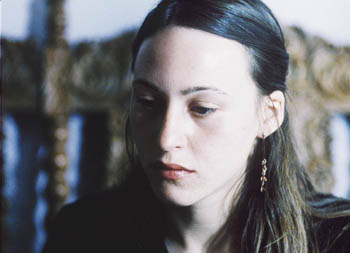![[Metroactive Movies]](/movies/gifs/movies468.gif)
[ Movies Index | Show Times | Silicon Valley | Metroactive Home | Archives ]
War's Boot Prints
In 'Notre Musique,' Godard tackles the problem of the comfortable understanding the afflicted
By Richard von Busack
TEN MINUTES of hell, about 10 minutes of heaven, nearly an hour in purgatory: Jean-Luc Godard's latest, Notre Musique, is framed like Dante's The Divine Comedy. In Notre Musique, notre maître uses his own cinematic-essay style to pose the question of why mankind ignites its holocausts. The hell sequence is the most dramatic. That's hell for you—naturally dramatic. Godard assembles a wordless montage that is madder and more jagged than the (Chuck) Workman—like snippets on the Oscars. Bits of battle scenes from Alexander Nevsky collide with Zulu and the Robert Wise Helen of Troy. The endless parade of soldiers bump into allegorical images: the dead slaves grinding sugar cane in White Zombie and the nuked beach house in Kiss Me Deadly.
The heaven scene is just as troubling, though more limpid; first, a phone call gives bad news to Godard puttering in his flower garden. Death is a long, quiet river in the woods. On its banks, a newly dead girl can't communicate with her fellow spirits. In a razory joke, Godard includes cyclone fences and armed U.S. soldiers in his paradise. (Hint: "The Marine's Hymn"'s lyrics: "If the Army and the Navy ever gazed on heaven's scenes.") Disillusioned of her final illusion about the sweetness of the hereafter, the dead lady paraphrases Philip Marlowe's epitaph for Velma in Raymond Chandler's Farewell, My Lovely.
As always, Godard and his onscreen commentators begin with generalities, then aim for a specific case. So, his "purgatory" is the polyglot city of Sarajevo, with the boot prints of war still visible on it. Godard visits the Balkan city in the summer and in the snow, recording conversations, gazing impassively at the constant passage of streetcars. His camera visits the scene of the Serbian war's great cultural atrocity: the wanton demolition of the 450-year-old Mostar bridge.
As one of the artists attending a Sarajevo culture fair, Godard gives a lesson on "the text and the image." An example he unpacks is Howard Hawks' use of symmetrical reverse angles in a scene of Cary Grant and Rosalind Russell on the telephone in His Girl Friday. Can man and women can be regarded as equals? If so, he implies, it's possible that the idea of the self and the other could be similarly vanquished and the root of all wars could be unrooted.
Notre Musique dances from the lucid epigram to the muffled image—a pantomime at a library is particularly baffling. Still, working beyond common ideas of good and evil, Godard makes a nobly touching film about the fate of Sarajevo—and the Sarajevos to come.
"Paradise was assaulted by the devil." That's how Gen. Dallaire in Shake Hands With the Devil sums up the Rwanda massacres. Trusting neither the devil nor paradise, Godard's makes his accusation broader: "The world is now split in two, between those who live on to voice their misery, and those for whom the public display provides a daily dose of moral comfort to their dominion."
[ Silicon Valley | Metroactive Home | Archives ]
![]()

Musing: Sarah Adler struggles to understand the flux of historical events in 'Notre Musique.'
Notre Musique (Unrated; 80 min.), directed and written by Jean-Luc Godard, plays June 29 at 7:30pm at the French Film Club at the Palo Alto Art Center, 1313 Newell Road.
Send a letter to the editor about this story to letters@metronews.com.
From the June 22-28, 2005 issue of Metro, Silicon Valley's Weekly Newspaper.